Whitepaper: Introduction to
remote virtual tower
Virtually all modern controlled airports are equipped with a staffed
tower to provide air traffic services to operate and maintain arrival,
departure and ground movement for commercial and non-commercial
aircraft. However, increasing pressure to reduce costs and modernise
service is compelling air navigation service providers (ANSPs) to
rethink the status quo and to explore new concepts for air traffic
management (ATM), such as remote virtual tower (RVT). Remote virtual
towers can locate ATM services for multiple airports at one central
location, thus creating several possibilities for synergy and savings.
This document will help air navigation service providers understand
the remote virtual tower concept, including:
• A description of remote virtual tower
• The advantages and potential savings of remote virtual tower
• How to transition to remote virtual tower.
August 2016
Air Traffic Management
© 2016 Frequentis — All rights reserved
�
Table of contents
1 The remote virtual tower concept ........................................................................................................3
1.1 Definition of remote virtual tower ......................................................................................................4
1.2 Usage scenarios for a remote virtual tower ......................................................................................4
1.3 Benefits of using a remote virtual tower ...........................................................................................5
1.3.1 Cost saving aspects .................................................................................................................5
1.3.2 Service in remote areas ..........................................................................................................6
1.3.3 Security critical areas .............................................................................................................6
2 Components of a remote virtual tower ...................................................................................................7
2.1 Basic profile ........................................................................................................................................7
2.2 Enhanced profile ................................................................................................................................9
3 Transition to remote virtual tower ........................................................................................................10
4 Pilot implementation management plan ..............................................................................................11
4.1 Planning and organisation ................................................................................................................11
4.2 Site infrastructure ............................................................................................................................12
4.2.1 Remote tower centre Infrastructure .....................................................................................13
4.2.2 Airport site infrastructure ....................................................................................................13
4.2.3 Transport, mounting and installation of equipment .............................................................13
4.2.4 Sourcing of parts and equipment in the country ..................................................................13
4.3 Network infrastructure provision ....................................................................................................13
4.3.1 Network performance requirements ...................................................................................14
4.3.2 Network reliability .................................................................................................................14
4.4 Validation procedure definition ........................................................................................................14
5 Rules and regulations ............................................................................................................................16
6 Abbreviations ..........................................................................................................................................18
7 References ..............................................................................................................................................19
8 Appendix A: Comparision between regular towers and remote virtual towers. ...............................20
8.1 Standardisation and ongoing activities ............................................................................................20
8.2 Tower operations ..............................................................................................................................20
8.3 Procedures .......................................................................................................................................21
8.4 Infrastructure ...................................................................................................................................22
8.5 Controllers view – regular ATC tower .............................................................................................23
8.6 Controllers view – remote virtual tower ..........................................................................................23
2
Whitepaper: Introduction to remote virtual tower
�
1 The remote virtual tower concept
Air transportation has spread throughout the world,
and flight traffic as well as passenger numbers are
continuously increasing. Air transport has grown to
include many smaller towns and remote locations,
providing these locations with an indispensable traffic
link and connection to major airports.
As the use of flying has grown, there is an increasing
pressure on air navigation service providers ANSPs to
reduce the operating costs of air traffic management
ATM, especially for medium size and small airports.
ATM services constitutes a fixed cost, which is hard
to cover by relatively small air traffic. A fully equipped
and operational tower at a small airport servicing only
a handful of take-offs and landings per day can be an
economic burden, which may overstretch the financial
capabilities of low-traffic airports.
Remote virtual tower RVT is a possible solution for
such airports to improve their profitability, offer longer
opening hours, or prevent from being closed down. In
addition, RVT also introduces a level of flexibility that
allows service levels to be enhanced.
The goal of a RVT is to give airports remote control
capabilities and introduce video-based control for
ATM services in safety-critical environments. RVT
replaces the visual view of flight craft movement and
the terminal area of an airport, and enables ANSPs to
provide air traffic services from a remote location with
virtually the same visibility as a local tower.
RVT replaces the onsite view of the airport control
tower with a visualisation system located at a remote
site by using high resolution visual / infrared (IR)
cameras, optimised for wide-range coverage by
providing a video presentation that uses object
detection and alerting functions together with
information enhancement.
Today
Tomorrow
Figure 1: Todays and tomorrows layout of a controller working
position
Operating a tower remotely opens a wide range of
synergies, since it allows co-location of several towers
to one remote tower centre (RTC), where several
airports are controlled centrally by the same staff –
providing better utilisation of resources.
Figure 2: General topology of a remote virtual tower solution
Whitepaper: Introduction to remote virtual tower — The remote virtual tower concept
3
�
1.1 Definition of remote
virtual tower
The Single European Sky ATM Research (SESAR)
defines remote virtual tower as follows.
A remote virtual tower is where air traffic services
(ATS) are remotely provided through direct visual
capture and visual reproduction (e.g. with cameras).
The ATS are provided using a remote tower module
(RTM), which includes operator workstation(s), ATM
systems and display solutions.
A remote tower module is the term for the complete
module, including both the controller working
positions (CWPs) and the visual reproduction display
screens.
A remote tower centre is a building where ATS are
located to serve one or more airports. It usually
includes several RTMs.
1.2 Usage scenarios for a
remote virtual tower
The Single European Sky ATM Research programme
has defined three different operational types of remote
virtual tower:
• Single remote virtual tower
• Multiple remote virtual tower
• Contingency remote virtual tower.
Single: The single remote virtual tower configuration
contains a RVT module and CWP dedicated to a single
remote airport. The configuration is used to provide
ATS to a dedicated airport and not switched between
airports.
Multiple / sequential configuration: This configuration
supports multiple airports controlled from a single
remote tower module and CWP. In the sequential
configuration, the module and CWP are connected to
two or more airports, but only one airport at time. The
module and CWP can be switched from one airport to
the next.
The typical case where the sequential configuration
applies is where multiple airports are managed on a
common schedule and the airports are opened and
closed in a sequential manner based on scheduled
activity.
Figure 4: Topology of a multiple sequential configuration
Multiple / simultaneous configuration: This
configuration also supports multiple airports
controlled from a single remote tower module and
CWP. In the simultaneous configuration, the module
and CWP enable ATS to operate for two or more
airports at the same time.
Figure 5: Topology of a multiple simultaneous configuration
Figure 3: Topology of a single configuration
4
Whitepaper: Introduction to remote virtual tower — The remote virtual tower concept
�
Contingency: The contingency configuration is when
a module and CWP are used as a redundancy for an
ordinary tower.
Among the three configurations — single, sequential,
and simultaneous — there are many different varieties
of remote virtual tower implementation. For example,
a shared remote virtual tower is a configuration where
traditional controls are used for an airport for normal
traffic hours, and the centralised RVT takes over.
1.3 Benefits of using a
remote virtual tower
1.3.1 Cost saving aspects
The major revenue sources of airports are landing
fees and passenger fees. These two correlate a
roughly linear relation with air traffic. No flights and
no passengers mean no revenues; many flights – many
passengers – mean good revenues.
ATS have to be in place even if there is only a handful
of air movements. For low traffic airports, the fixed
costs for providing ATS are independent of the number
of flights and passengers. For high traffic airports,
the variable costs for providing ATS grow slowly, as
more air traffic control officers (ATCOs) and more
work places are needed. However, this growth is not
proportional to the growth of revenues due to more
flights and passengers.
Source: Helios
Figure 6: Economic aspects of remote virtual tower
The costs for providing ATS at an airport include:
• Fixed ATM costs — independent of the traffic flow
• Full ATM staffing at each tower
• Investments in tower building, refurbishment
and facility management
• Maintenance costs
• Site-specific training.
If there is little air traffic, and landing fees and
passenger fees do not cover the costs for providing
ATS, airports will not reach the break-even point.
The International Civil Aviation Organization (ICAO)
clearly defines the requirements for ATS in its
Procedures for Air Navigation Services. Reducing the
level of service below the ICAO minimum level is not
an option. The cost saving potential on the service level
side is therefore limited.
However, in order to provide ATS in compliance with
international regulations, it is not necessarily required
to have ATCOs placed on-site at airports. As long as
the ICAO-mandated service level is kept, the out-of-
the-window view can be substituted by a video-based
view. Thus, ATCOs can be located remotely from an
airport.
Even if a single airport is handled by a single remote
virtual tower, there is some savings potential. The
single configuration enables operators to work
remotely, optimising shift changes and the number of
supervisor positions.
However, co-locating multiple RVTs into one remote
tower centre (RTC) can maximise savings by allowing
the sharing of resources, since more than one airport
can be handled by one controller in time shift mode.
Employing the synergies of hosting and co-using
several RVTs in one RTC opens many possibilities,
chiefly in the areas of facility, operations and
resources:
Facility: For airports which already have a tower,
after migration to remote virtual tower, facilities
in an existing tower can also be re-used by other
departments of the airport, e.g. as offices. This may
save on costs (e.g. constructing new office building).
Operations: Instead of full-fledged towers, only
masts with cameras and sensors need to be operated
and maintained. Due to centralisation, there will be
substantial savings in areas such as:
• Centralised data centre and IT
• Centralised operations centre
Whitepaper: Introduction to remote virtual tower — The remote virtual tower concept
5
�
1.3.2 Service in remote areas
Remote virtual tower technology can control airport
traffic from remote locations. This allows remote
tower centres to be placed in populated or attractive
places (e.g. larger cities, emerging regions). It is
easier to find skilled and educated people in such
areas, simplifying staffing and recruiting. This also
provides a long-term perspective for people in their
jobs and high flexibility of resources.
1.3.3 Security critical areas
Another factor for deploying remote virtual tower
technology is security. A control tower at an airport is
an obvious target and could be subject to bombing or
other attack. The remote virtual tower approach keeps
personnel at a safe, secure and protected location.
Additional technology (e.g. infrared-based night vision
cameras, video-based object detection) can be used
as an enhancement for the remote virtual tower for
infrastructure protection and monitoring.
• Remote administration and monitoring
• Remote IT support.
Resources: Instead of resources at each airport,
which may be under-utilised due to little air traffic,
centralised resources can handle several airports and
can employ a steady workload. Examples include:
Combining resource for multiple airports (time
shifting): A controller can use time between scheduled
traffic at one airport for other tasks, such as handling
services for another airport, training or preparation
work.
Combining activities from several airports: At
small airports, there are still two controllers to
manage traffic and provide support functions. With
RVT, functions such as clearance delivery or flight
information tasks of multiple airports can be assigned
to one person. As a result, one controller could focus
on tactical operation and service air movement and
ground movement in a combined way.
Optimising night shifts: During night shifts with low
traffic, one controller can monitor three airports,
resulting in a saving of two ATCOs,
or 66% per night shift.
Combining supervisor activities: A tower is normally
equipped with at least one ATCO for air movement, one
ATCO for ground movement and one supervisor. In an
RTC environment, one supervisor can handle three
airports, resulting in a saving of two supervisors or
66% per shift.
6
Whitepaper: Introduction to remote virtual tower — The remote virtual tower concept
�
2 Components of a remote virtual tower
To fulfil the task of ATM, an Airport Traffic Control
Tower of a conventional airport must have:
• Out-of-The-Window (OTW) view and binoculars
• Light guns
• Meteorological information
• Navigation aids status information
• Airfield Lighting control
• Air/ground and ground/ground voice communication
• Recording systems
• Flight data handling.
2.1 Basic profile
In a remote virtual tower installation, cameras replace
the OTW — the view of the airport is presented to the
ATCO electronically. This makes it possible for the
ATCO to be located at a remote virtual tower, far away
from the airport.
A typical remote virtual tower installation consists of:
• Equipment at the local airport
• Working positions at the remote virtual tower
Centre
• A transmission network in between.
External interfaces are situated at the local airport or
at the RTC. Depending on the implementation, some
of these interfaces and the systems/sensors might be
included in the remote virtual tower solution. In other
cases, such sensors might already exist and need to
be integrated into the remote virtual tower system,
e.g. meteorological sensors, navigational aids, VHF
radios.
Figure 7: Components of a remote virtual tower Solution
Whitepaper: Introduction to remote virtual tower — Components of a remote virtual tower
7
�
The heart of a remote virtual tower solution is
cameras placed at the host airport.
The cameras are mounted to capture a 180° or 360°
view and they can be mounted at optimal locations
at the airport, since they only need a mast and not a
complete tower building. They can be distributed all
over the airport to avoid any shadowed areas.
Figure 9: CWP in a remote virtual tower
throughput, low latency, low bit error rate) to carry
the video streams from the cameras to the working
position. Figures for the required QoS are given later
in this paper.
At a remote virtual tower, the main component is the
controller working position (CWP). The CWP needs to
be designed with human factor guidelines in mind, and
it features:
• A compact working position design
• High-resolution display technology
• Combined control panel (flight strips, camera
control, control functions for AFL, ATIS).
Typically, a remote tower centre will include several
CWPs, depending on the size, traffic volume and
number of connected airports. A data centre serves
the CWPs, and connects the remote virtual tower to
the WAN, providing the necessary IT infrastructure to
handle voice and data traffic from different airports.
Figure 8: Cameras at the local airport
For relaying data and voice to a remote virtual tower,
data and voice gateways are added at the local airport
and integrated into the existing infrastructure. These
network elements serve as gateways to connect the
local airport and the remote virtual tower via a wide
area network (WAN).
The network between the local airport and the
remote virtual tower is key to the remote virtual tower
implementation. It needs to have high availability
and redundancy, and provide a very high QoS (high
Figure 10: A remote tower centre consists of several CWPs and a desk for a supervisor
8
Whitepaper: Introduction to remote virtual tower — Components of a remote virtual tower
�
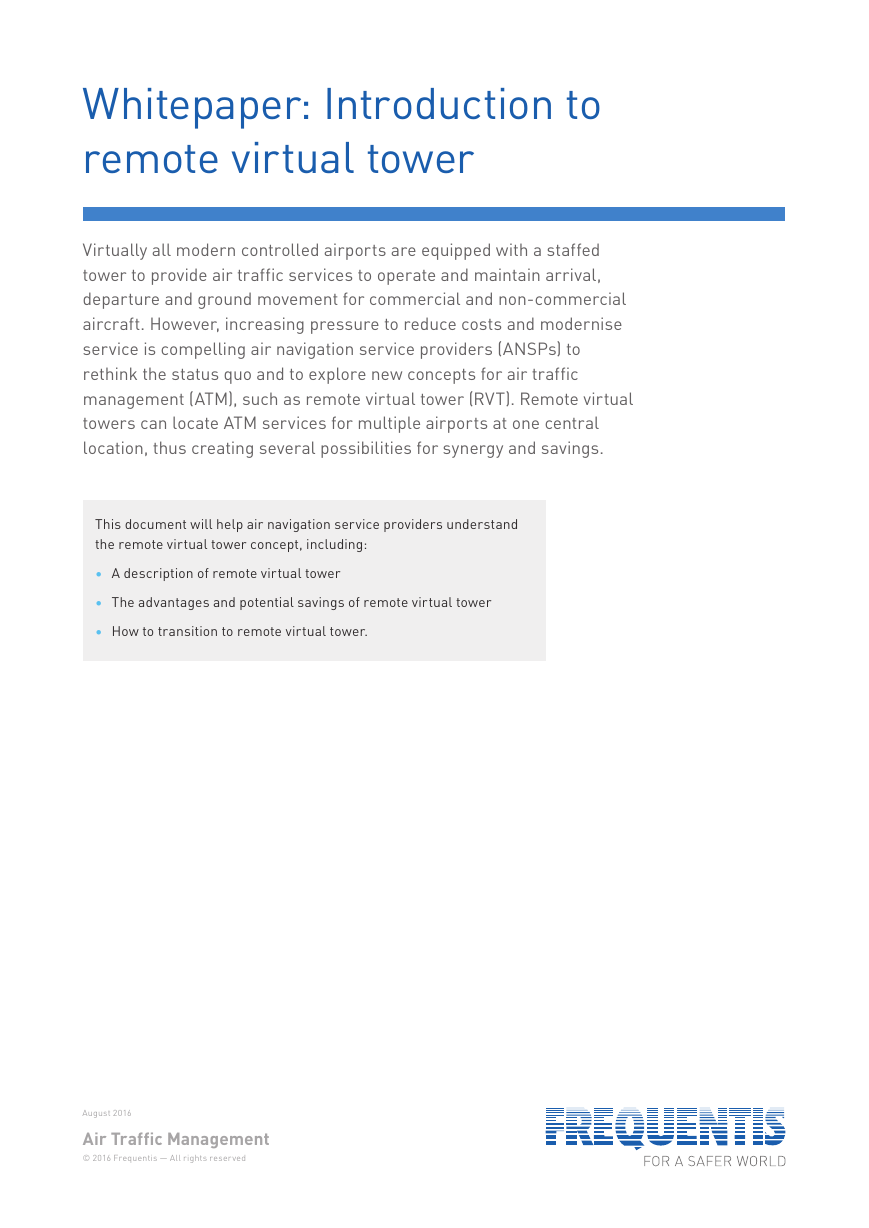
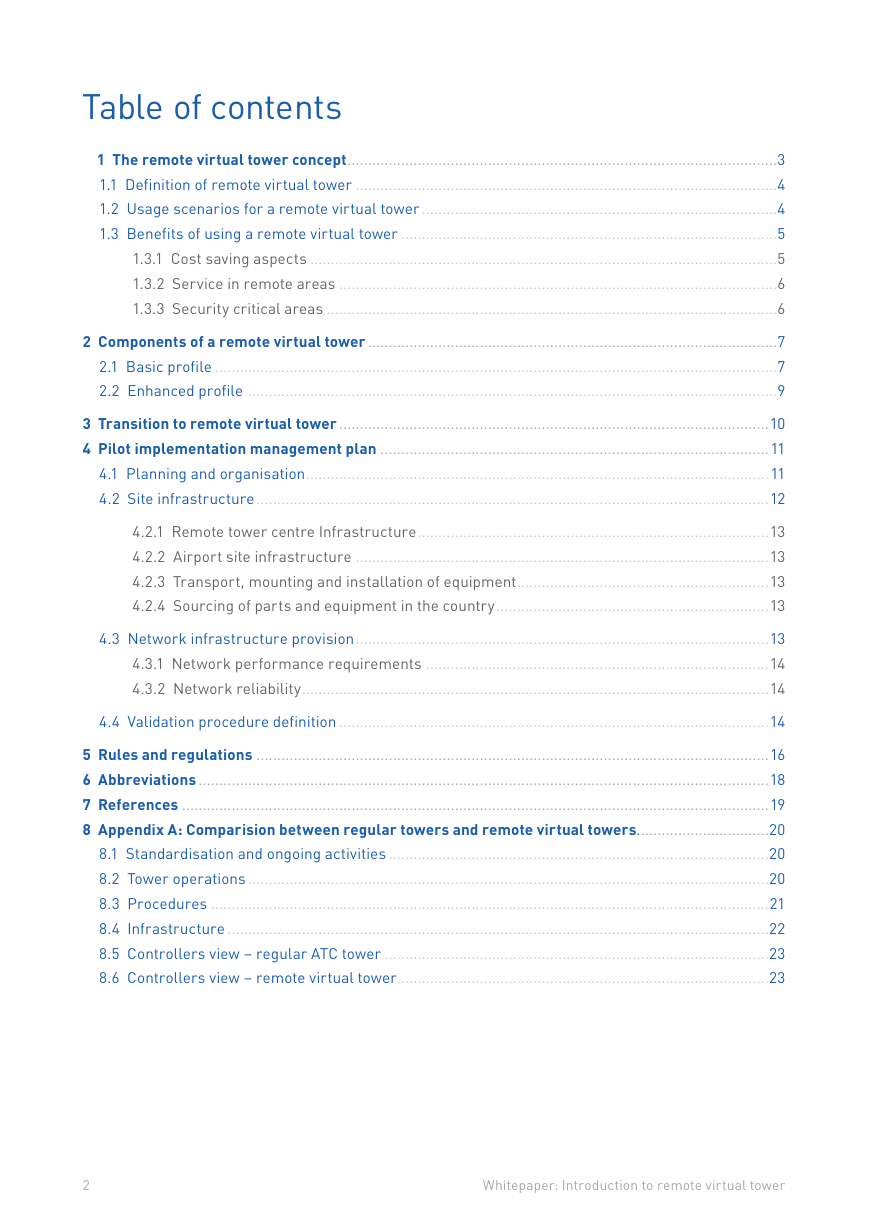
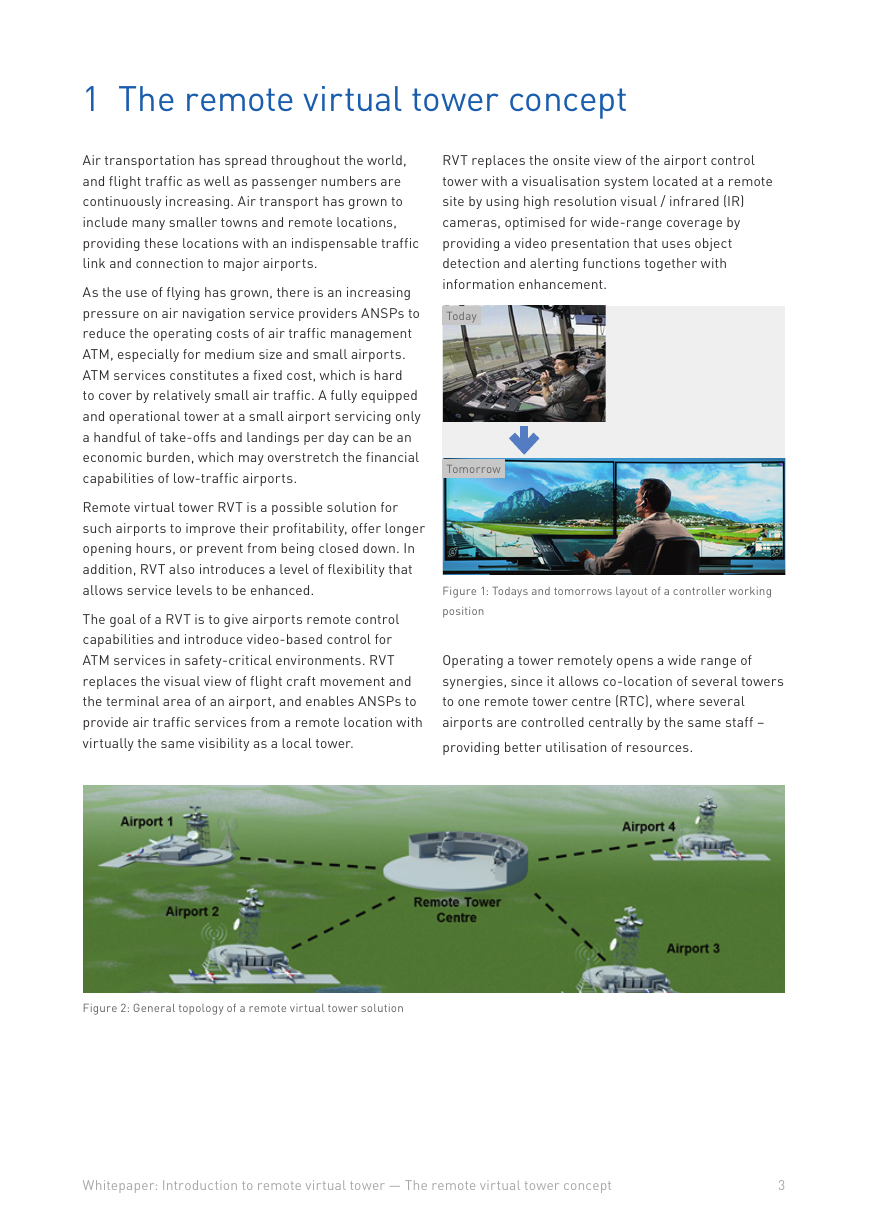

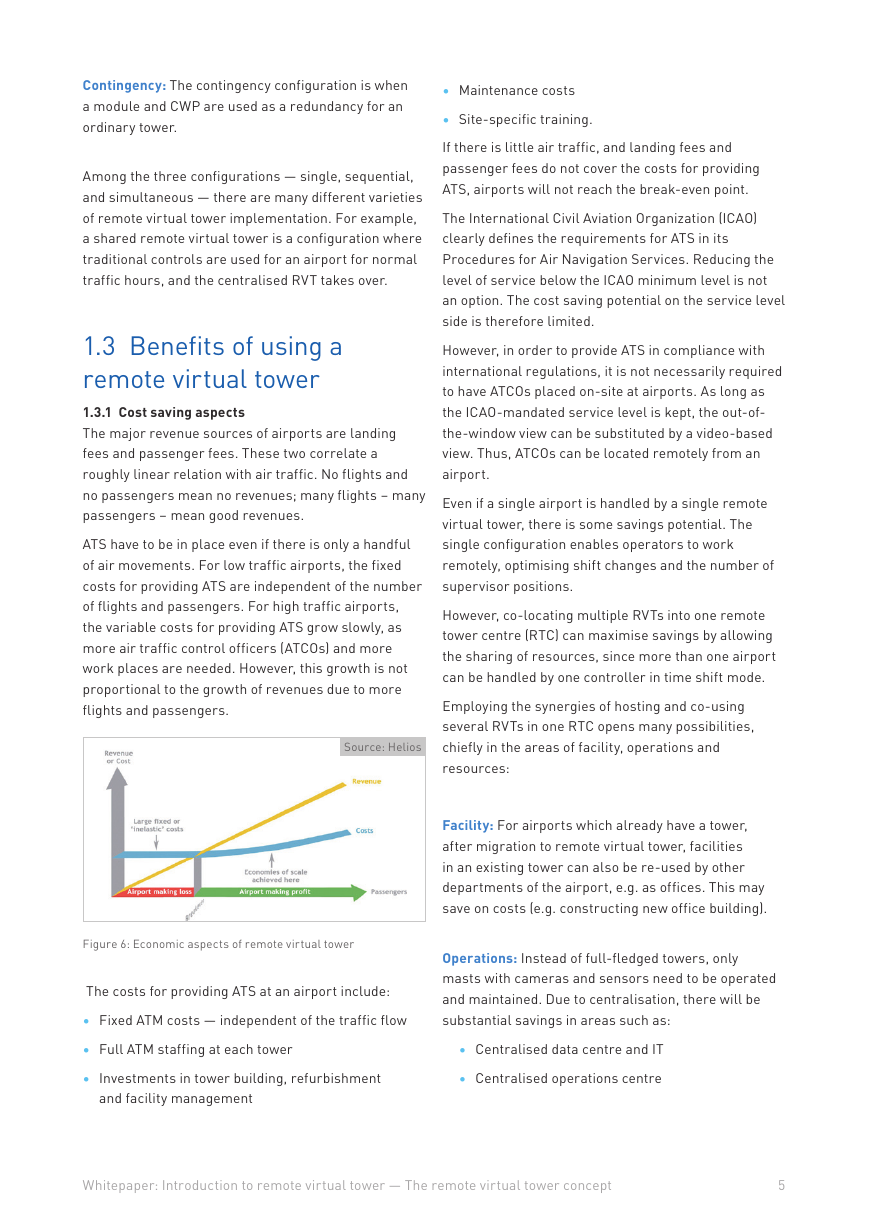
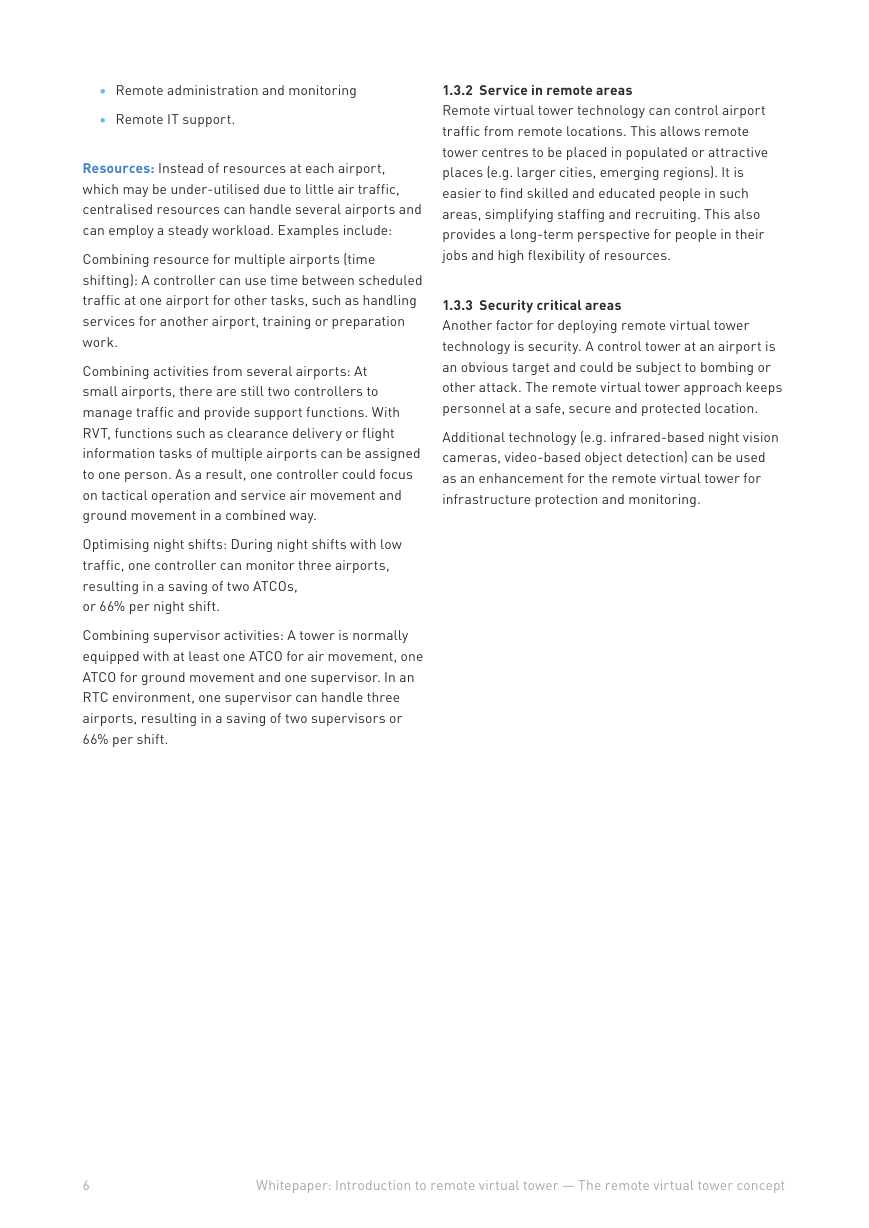
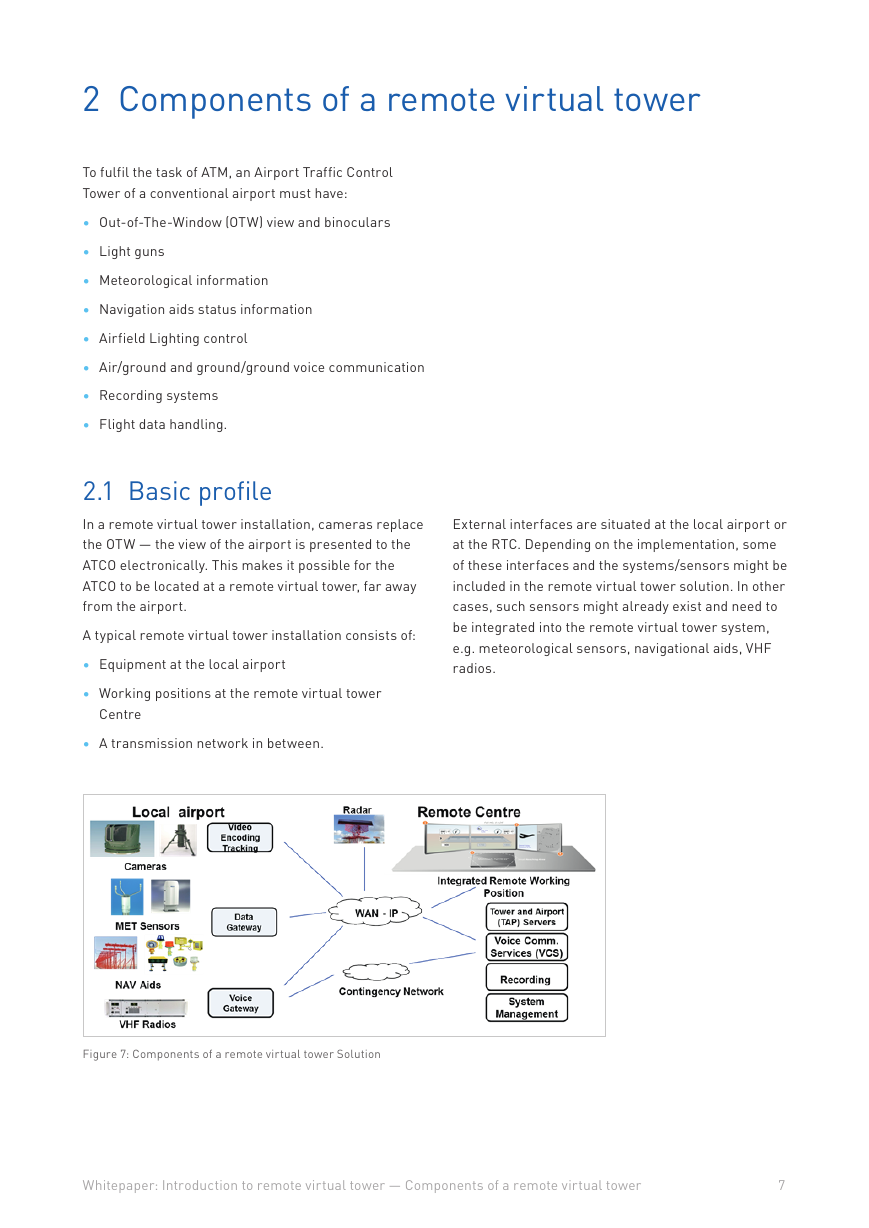
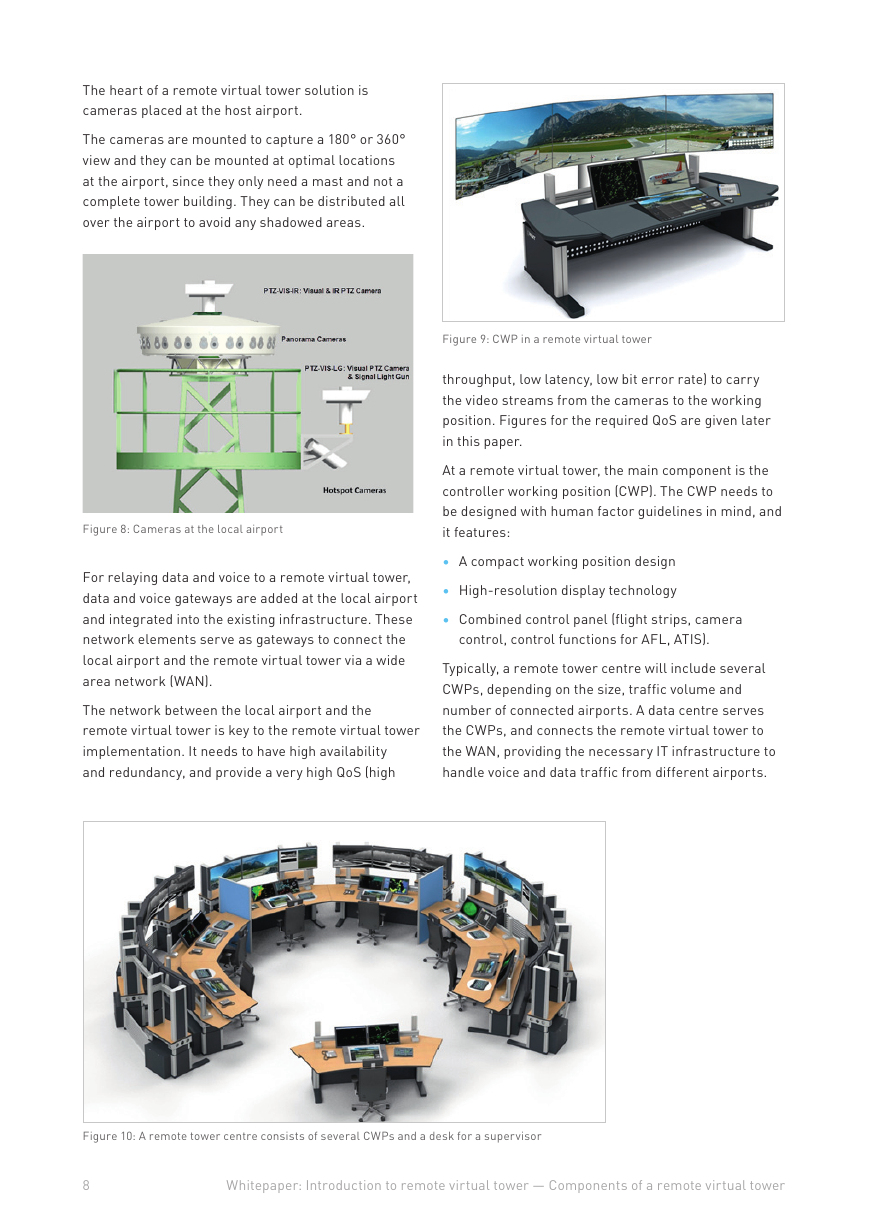








 2023年江西萍乡中考道德与法治真题及答案.doc
2023年江西萍乡中考道德与法治真题及答案.doc 2012年重庆南川中考生物真题及答案.doc
2012年重庆南川中考生物真题及答案.doc 2013年江西师范大学地理学综合及文艺理论基础考研真题.doc
2013年江西师范大学地理学综合及文艺理论基础考研真题.doc 2020年四川甘孜小升初语文真题及答案I卷.doc
2020年四川甘孜小升初语文真题及答案I卷.doc 2020年注册岩土工程师专业基础考试真题及答案.doc
2020年注册岩土工程师专业基础考试真题及答案.doc 2023-2024学年福建省厦门市九年级上学期数学月考试题及答案.doc
2023-2024学年福建省厦门市九年级上学期数学月考试题及答案.doc 2021-2022学年辽宁省沈阳市大东区九年级上学期语文期末试题及答案.doc
2021-2022学年辽宁省沈阳市大东区九年级上学期语文期末试题及答案.doc 2022-2023学年北京东城区初三第一学期物理期末试卷及答案.doc
2022-2023学年北京东城区初三第一学期物理期末试卷及答案.doc 2018上半年江西教师资格初中地理学科知识与教学能力真题及答案.doc
2018上半年江西教师资格初中地理学科知识与教学能力真题及答案.doc 2012年河北国家公务员申论考试真题及答案-省级.doc
2012年河北国家公务员申论考试真题及答案-省级.doc 2020-2021学年江苏省扬州市江都区邵樊片九年级上学期数学第一次质量检测试题及答案.doc
2020-2021学年江苏省扬州市江都区邵樊片九年级上学期数学第一次质量检测试题及答案.doc 2022下半年黑龙江教师资格证中学综合素质真题及答案.doc
2022下半年黑龙江教师资格证中学综合素质真题及答案.doc